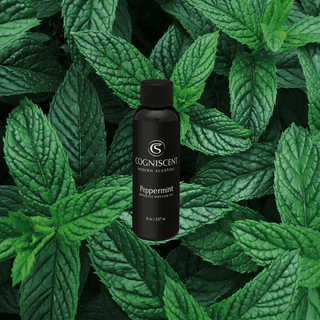Nearly Essential Oils (NEO)
Introducing CogniScent's NEO Line: Nearly Essential Oils
Experience the benefits of aromatherapy without the common drawbacks of traditional essential oils with CogniScent’s NEO line—our Nearly Essential Oils designed to offer a consistent and stable scent experience.
Understanding Terpenes and Their Role in Essential Oils
Terpenes are naturally occurring compounds found in plants, including those used to produce essential oils. They are responsible for the distinctive scents of various plants, such as lavender, citrus, and pine. Terpenes also contribute to the therapeutic properties of essential oils, making them a key component in aromatherapy. However, while terpenes offer numerous benefits, they are also highly reactive and can oxidize when exposed to air, light, or heat.
The Downside of Oxidation
When terpenes oxidize, they undergo chemical changes that can lead to the formation of irritating compounds. This oxidation not only alters the scent of the essential oils but can also make them less effective and more likely to cause skin sensitization or respiratory irritation. Here are some of the most reactive terpenes and how they become more potent irritants when oxidized:
-
Limonene: Found in citrus oils, limonene oxidizes into limonene hydroperoxides, which are strong skin sensitizers and irritants.
-
Linalool: Present in lavender and coriander oils, linalool oxidizes to form linalool hydroperoxides, significant skin sensitizers that can cause allergic reactions.
-
Geraniol: Found in rose and citronella oils, geraniol oxidizes to produce geranial and other compounds that can irritate the skin.
-
Citral: A component of lemongrass and lemon myrtle oils, citral oxidizes into potent skin sensitizers and irritants, including oxidized forms of neral and geranial.
-
Eucalyptol (1,8-Cineole): Found in eucalyptus and rosemary oils, eucalyptol can produce irritating compounds upon oxidation, particularly affecting the respiratory system.
-
Alpha-Terpineol: Found in pine oil and lilac, alpha-terpineol forms irritating oxidation products that can cause skin sensitization.
-
Carene: Common in cypress and fir oils, carene becomes an irritant, especially to the respiratory system, when oxidized.
-
Farnesene: Although less reactive, oxidized farnesene can still form irritating compounds.
Crafted for Stability: The NEO Difference
At CogniScent, we understand the challenges posed by these reactive terpenes. That’s why our NEO oils are expertly crafted using essential oil extracts blended with synthetic ingredients to stabilize the molecules. This process ensures that the oils maintain their integrity over time, providing a long-lasting and consistent aromatherapy experience without the risk of rot, oxidation, or the formation of irritating compounds.
Less Reactive, More Reliable
Thanks to our stabilization process, NEO oils are less reactive than pure essential oils, making them a safer and more reliable choice for individuals seeking the therapeutic benefits of aromatherapy without the potential irritants found in traditional oils.
Discover the NEO Difference
CogniScent’s NEO line offers an advanced approach to aromatherapy. By combining the best of nature with scientific innovation, we’ve created a line of Nearly Essential Oils that deliver consistent, stable, and therapeutic scents—supporting your wellness journey without the downsides of traditional essential oils.
- 2oz / 59 mL
- 8oz / 237 mL
- 1lb / 474 mL
- 1.5lb / 711 mL
- 2oz / 59 mL
- 8oz / 237 mL
- 1lb / 474 mL
- 1.5lb / 711 mL
- 2oz / 59 mL
- 8oz / 237 mL
- 1lb / 474 mL
- 1.5lb / 711mL
- 2oz / 59 mL
- 8oz / 237 mL
- 1lb / 474 mL
- 1.5lb / 711 mL
- 2oz / 59 mL
- 8oz / 237 mL
- 1lb / 474 mL
- 1.5lb / 711 mL
You’re viewing 1-5 of 5 products





